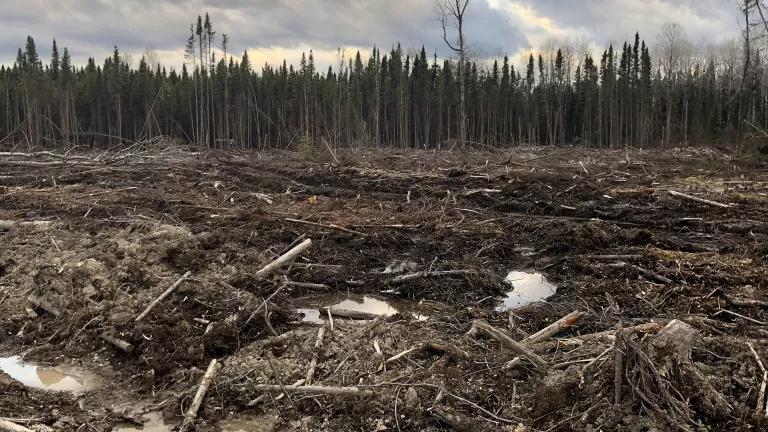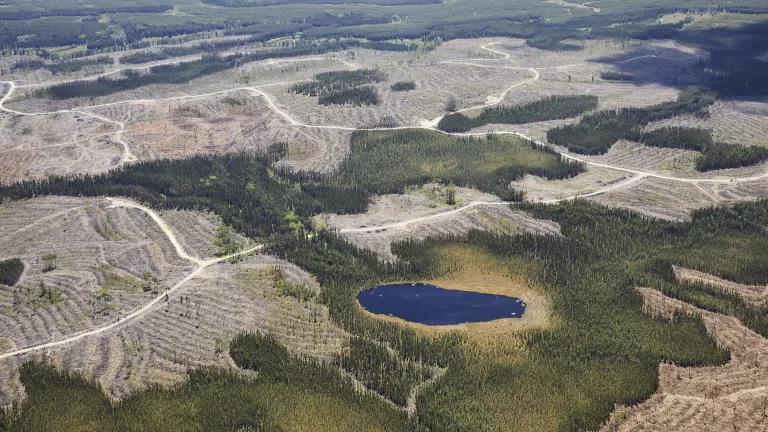Canada’s Overdue Reckoning with Unsustainable Logging
Canada remains willfully blind to one of its most significant drivers of biodiversity loss and climate change: industrial logging.

Clearcut logging in Quebec
The project of planetary habitability isn’t one of piecemeal funding and planted trees. It’s one, as scientists have warned, requiring accountability for the key drivers of climate and biodiversity collapse and, ultimately, transformative change. Unfortunately, Canada has failed to pursue that more systemic self-examination, remaining willfully blind to one of its most significant drivers of biodiversity loss and climate change: industrial logging. That accountability has to come quickly, if Canada is going to propel meaningful change under the new Kunming-Montreal Global Biodiversity Framework (GBF), enshrined this week at the UN biodiversity conference (COP15).
Just days before the start of COP15 in Montreal, press revealed that Canada had been lobbying against key provisions of a landmark European Union forest regulation that, breaking with a longstanding impunity for forest impacts outside the tropics, holds countries in the Global North accountable for their logging industries’ impacts.
Canada’s opposition was far from an aberration—it was grounded in a decades-long, globally pervasive tradition of unflinching fidelity to its logging industry and the myths obscuring the sector’s impact on irreplaceable forests, the climate, and biodiversity.
Each year, industrial logging in Canada clearcuts more than 1.3 million acres of forest, much of this in never-before-logged primary forests that are essential to meeting global climate and biodiversity targets. Canada, in fact, is an international frontrunner in its destruction of these forests, ranking third globally in loss of intact forest landscapes, behind only Russia and Brazil.
This unsustainable logging has driven species like boreal caribou, which depend on primary forests, to the brink, and eroded essential habitat for migratory birds beloved across the Americas. Industrial logging is also, just like the oil and gas sector, a contributor to global climate change, accounting for more than 10 percent of Canada’s annual greenhouse gas emissions.
Canada’s logging practices, in other words, are a foundational driver of both biodiversity loss and the climate crisis.
Yet, over decades, Canada has engaged in a campaign of denial over this impact, branding logging practices, including the clearcutting of primary forests, as “sustainable forest management.” Canada does not transparently report on the logging industry’s greenhouse gas emissions, as it does for all other high-emitting sectors, and, in fact, effectively buries the logging industry’s climate cost by allowing the sector to take credit for carbon removed by forests it has never cut. This year, the government failed to step in in the face of provinces’ failure to address boreal caribou declines, for example signing a plan with Ontario that effectively allows business-as-usual logging in critical habitat.
Even as the delegates at COP15 were finessing the language of the GBF, Natural Resources Canada released its State of the Forest Report, an annual paean to the logging sector that provides an almost unadulterated endorsement of logging as not only sustainable, but a boon to the climate and biodiversity. This came just a week after revelations of Canada’s lobbying for the EU to strip forest degradation provisions that would expand accountability beyond deforestation in the tropics to include unsustainable logging in the Global North.
While Canada had a number of profound and welcome announcements at COP15, it continued to deflect attention from logging’s role in the biodiversity crisis. The Trudeau government committed, for example, to restoring 190,000 square kilometers of degraded forests by 2030—a laudable move, but at current logging rates, Canada will clearcut an area more than twice that size in that same period, much of that in irreplaceable forests.
This continued failure to grapple with logging’s impact risks undermining Canada’s ambition under the new GBF, positioning Canada to spend the next decade putting Band-Aids on a fundamentally broken system.
Even worse, it could turn the GBF into a tool for further greenwashing the country’s practices.
The headline commitment within the GBF—to protect 30 percent of lands and waters by 2030 (30x30)—is only as strong as the rigor of the meaning of “protection” and as a prioritization of protecting places with the highest value for the climate and biodiversity. During the first week of COP15, Prime Minister Trudeau indicated that Canada may allow some industrial extraction in protected areas, while still counting them toward 30x30. It could also incentivize Canada to focus solely on protecting areas of little value to the logging industry. Quebec modeled this tactic in 2020, when it rejected most of the Indigenous-led protected area proposals in its potential logging areas, meeting its protection target through safeguarding almost exclusively regions where this wouldn’t impinge upon the logging industry.
Canada’s recognition of the logging industry’s impact isn’t just essential for biodiversity and the climate—it’s also vital for the industry itself. The marketplace has placed increased scrutiny on companies’ forest and human rights impacts, while, particularly on the heels of the GBF and with the new EU regulation, the financial sector seems poised to cast an increasingly discerning eye on logging’s impacts. This means that the logging sector’s long-term viability depends on aligning itself with a sustainable and just future.
Within the new GBF, there’s a phrase that distills the scale of ambition needed to pull the world back from the brink of a Sixth Extinction: it calls for a “transformation in our society’s relationship with biodiversity.” Canada can lead on that transformative change, creating diverse, and sustainable economies while preserving our natural world. However, transformation requires more than bandages over a still-growing wound. First, Canada needs to stop the bleeding.




